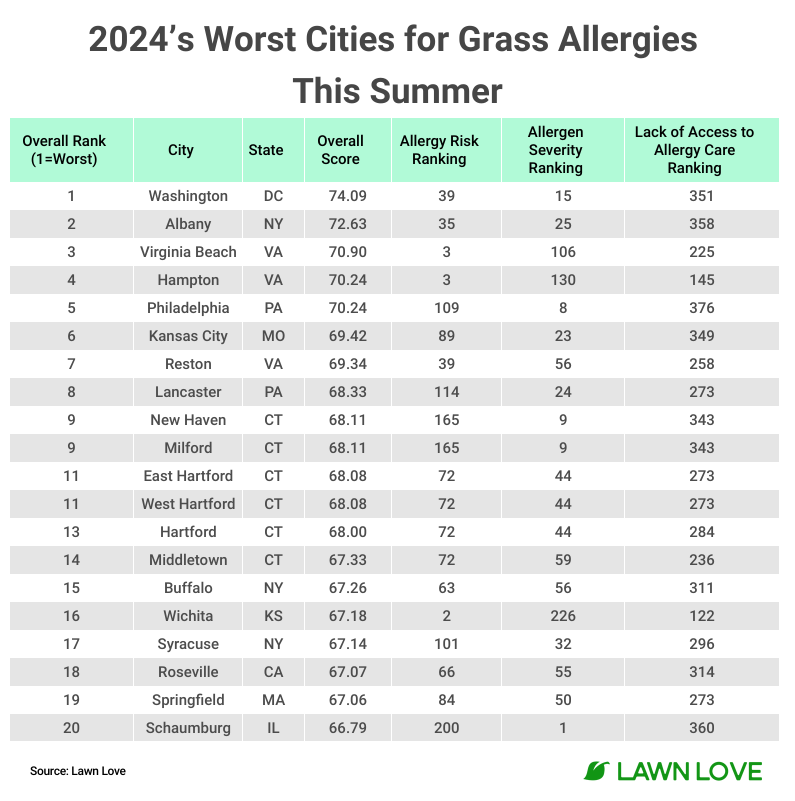Where is your summertime picnic on the grass most likely to trigger a stuffy nose and itchy eyes?
To mark Allergy and Asthma Awareness Month this May, Lawn Love ranked 2024′s Worst Cities for Grass Allergies This Summer.
Recommended Videos
We compared nearly 380 of the biggest U.S. cities based on allergy risk, exacerbators, and access to detection and treatment resources. More specifically, we looked at grass pollen forecasts, allergen intensity, and lawn mowing frequency, among 8 total metrics.
Get ahead of a congested allergy season with our ranking below. To learn how we ranked the cities, see our methodology.

Lawn Love
City rankings
See how each city fared in our ranking.
Top 5 close up
No. 1: Washington D.C. | Overall score: 74.09
- Average Forecasted Grass Pollen Index (May-August 2024): 2.4 | Rank: 56
- Historical Wind Speed (May-August 2020): 8.3 mph | Rank: 111
- Average Number of Significant Grass Allergens: 16 | Rank: 1
- Average Number of Moderate Grass Allergens: 20 | Rank: 27
- Average Number of Mild Grass Allergens: 38 | Rank: 9
Local tips:
- 4 Best Grass Types for Washington, D.C.
- 11 Spring Lawn Care Tips for Washington, D.C.
- 9 Best Native Plants for Your Washington, D.C., Yard
No. 2: Albany, New York | Overall score: 72.63
- Average Forecasted Grass Pollen Index (May-August 2024): 2.8 | Rank: 19
- Historical Wind Speed (May-August 2020): 6.9 mph | Rank: 252
- Average Number of Significant Grass Allergens: 14 | Rank: 22
- Average Number of Moderate Grass Allergens: 21 | Rank: 23
- Average Number of Mild Grass Allergens: 36 | Rank: 28
Local tips:
No. 3: Virginia Beach, Virginia | Overall score: 70.9
- Average Forecasted Grass Pollen Index (May-August 2024): 3.2 | Rank: 8 (tie)
- Historical Wind Speed (May-August 2020): 8.9 mph | Rank: 69 (tie)
- Average Number of Significant Grass Allergens: 11 | Rank: 101 (tie)
- Average Number of Moderate Grass Allergens: 16 | Rank: 87
- Average Number of Mild Grass Allergens: 27 | Rank: 140
Local tips:
- 8 Best Grass Types for Virginia Beach
- Best Native Plants for Virginia Beach
- Hurricane-Resistant Landscaping Ideas for Virginia Beach
No. 4: Hampton, Virginia | Overall score: 70.24
- Average Forecasted Grass Pollen Index (May-August 2024): 3.2 | Rank: 8 (tie)
- Historical Wind Speed (May-August 2020): 8.9 mph | Rank: 69 (tie)
- Average Number of Significant Grass Allergens: 11 | Rank: 101 (tie)
- Average Number of Moderate Grass Allergens: 14 | Rank: 126
- Average Number of Mild Grass Allergens: 23 | Rank: 218
No. 5: Philadelphia | Overall score: 70.24
- Average Forecasted Grass Pollen Index (May-August 2024): 2.1| Rank: 109
- Historical Wind Speed (May-August 2020): 8 mph | Rank: 160
- Average Number of Significant Grass Allergens: 15 | Rank: 3
- Average Number of Moderate Grass Allergens: 26 | Rank: 1
- Average Number of Mild Grass Allergens: 38 | Rank: 9
Local tips:
Key Insights
Stock up on allergy medication if you live in the nation's capital — Washington D.C. (No. 1) tied with Lancaster, Pennsylvania (No. 8), for the highest presence of significant grass allergens in our ranking.
Seven Illinois cities claim the most turf allergens overall — with high levels of mild, moderate, and significant allergens — followed by Philadelphia (No. 5), 6 Connecticut cities, and Washington D.C. Thankfully, Chicago (No. 39) boasts the 2nd-best access to allergy care after New York (No. 311).
Suburbs like Sandy Springs, Georgia (No. 370) and Paradise, Nevada (No. 377) have the worst access to allergy care, with no local allergists or immunologists to administer allergy tests and treatment. Luckily, their forecasts call for low levels of grass pollen this summer.
Turf allergy risk is lowest in some parts of Florida and Minnesota, with Fort Myers, Florida, finishing in last place. These 2 states have low grass pollen forecasts and less severe lawn allergens.
Behind the ranking
First, we determined the factors (metrics) that are most relevant to rank the Worst Cities for Grass Allergies This Summer. We then assigned a weight to each factor based on its importance and grouped those factors into 3 categories: Allergy Risk, Allergen Severity, and Lack of Access to Allergy Care.
For each of the 378 biggest U.S. cities, we then gathered data on each factor from the American Academy of Allergy, Asthma & Immunology, Lawn Love, National Oceanic and Atmospheric Administration, and Pollen.com.
Finally, we calculated scores (out of 100 points) for each city to determine its rank in each factor, each category, and overall. A city's Overall Score is the average of its scores across all factors and categories. The highest Overall Score ranked "Highest Risk" (No. 1) for grass allergies and the lowest "Lowest Risk" (No. 378) for grass allergies.
Climate change: Nothing to sneeze at
Allergies are getting worse.
Climate change is lengthening our allergy season by an average of 20 days and making allergens more intense. This is bad news for the more than 30% of Americans who sniffle, sneeze, and suffer from seasonal allergies.
Man's best friend isn't exempt from allergy season, either. Dogs can experience allergies from weeds and exposure to grass types like ryegrass, bermudagrass, fescue, and alfalfa.
There are some ways to minimize your exposure to grass pollen and resulting allergy symptoms, though — and they're right in your own backyard:
- Design an allergy-friendly landscape.
- Plant low-pollen trees and flowers.
- Avoid working outdoors in the morning, when pollen counts are highest.
- Keep an eye on your local pollen count before heading outside.
- Check the wind speed in your area — wind transmits a lot of pollen.
- Switch to artificial grass.
- Discover which grass allergens are most likely to affect your area this summer.
This story was produced by Lawn Love and reviewed and distributed by Stacker Media.